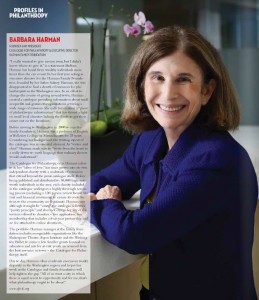Last week, The Chronicle of Philanthropy tackled the difficult subject of nonprofit mismanagement with “Keeping Quiet About Wrongdoing at Nonprofits Only Makes Matters Worse” by Ken Berger, president of Charity Navigator and Jeremy Kohomban, chief executive of the Children’s Village.
The article discusses how nonprofits tend to ignore media coverage of the wrongdoing and mismanagement that happens in the sector, and instead choose to believe that the end result — their good work in the community — will help the public overlook the problems that exist. Berger and Kohomban argue that nonprofits should not bury their heads in the sand, nor focus only on results, as this creates “a sense of denial and defensiveness throughout the nonprofit world that is damaging our credibility with the public.” They call for nonprofit leaders and board members to hold each other accountable and speak out when they see mismanagement happening.
At the Catalogue, we agree with the authors that there is much more to assessing how a charity operates than simply evaluating its results. Our review process encompasses the things Berger and Kohomban mention as being critical to evaluation: financial management, good governance, ethics, and high operating standards. We hope that with increased?accountability, our review process, and the processes being implemented by nonprofit leaders such as Berger and Kohomban, we can continue to elevate perceptions of the nonprofit sector.
Keeping Quiet About Wrongdoing at Nonprofits Only Makes Matters Worse
By Ken Berger and Jeremy Kohomban
New momentum has been growing to create activist organizations that defend nonprofits from public attacks and from regulations and laws they believe would harm their operations.
Witness the efforts of CForward, an organization that seeks to influence local and state politicians and went so far as to organize a PAC; and the Charity Defense Council, an effort to thwart unfair criticism.
Both groups are trying to give nonprofits more political muscle, and both are responding to the sensationalist news media, which more and more recognize that controversy sells and often present information about charities that lacks context, and in some egregious cases intentionally distort information.
The result has been that prominent journalists have depicted some well- functioning charities as incompetent or deceitful, and sometimes both.
To the extent that these efforts defend nonprofits that need defending and educate the public on the complexities and challenges facing the nonprofit world, we say bravo.
But we fear that too often, allegations of true mismanagement and scandal at nonprofits either get no response from charity and foundation leaders or, even worse, get a defense that cannot be justified.
Cases of mismanagement abound. Some researchers have estimated that tens of billions a year are lost as a result of unethical behavior, typically by leaders of nonprofits.
For example, last month William Rapfogel pleaded guilty to stealing more than $9-million from the Metropolitan Council on Jewish Poverty, an organization he led for more than 20 years. Mr. Rapfogel said he had been involved in a complex scheme with other top executives in which they systematically overpaid the council?s insurance and then obtained kickbacks from the insurance company.
One can’t pretend the news media sensationalize nonprofit corruption when it comes to such cases.
In our opinion, based on our 60 years of collective experience, a culture of constructive self-criticism has yet to embed itself in the ethos of most nonprofits, their staff leadership, and their boards of directors.
The reasons for these poor responses are varied.
Nonprofits, like other organizations, often follow a commonly held view about the best way to handle an attack: If you ignore it, the public will forget and move on. The media thrive on controversy, so don’t discuss it and don’t highlight it in any way and journalists will move on.
But many nonprofits also think that because they are doing important work that serves society, the public should focus on the end result and little else. What?s more, many nonprofit leaders believe it’s unnecessary to speak out because bad deeds are so rare at charities. Just like in business or government, wrongdoers exist, but nonprofits don’t see any reason why they should be held to a higher standard than any other institution when it comes to punishing bad players.
The result is a sense of denial and defensiveness throughout the nonprofit world that is damaging our credibility with the public.
We recognize the deep commitment of people who work at nonprofits and the great good they do for society. But we strongly disagree with those who believe “results are all that matters” when assessing how a charity operates.
Financial management, good governance, ethics, and high operating standards must continue to be vital measures of a nonprofit’s worthiness.
If a charity mismanages its finances, today’s results can be tomorrow’s bankruptcy. If a charity has poor governance, an unethical and unaccountable chief executive or board might embezzle funds that won’t go toward producing results. And if we persist in saying results are all we care about, we will continue to see a never-ending series of scandals and mismanagement that will rock the nonprofit world and damage the public trust.
We need to look at both performance and accountability for financial, operational, and results to assess nonprofits.
Charities should also be held to a higher standard of ethics because of the way we are structured and how we raise money. We benefit from tax exemptions and the charitable deduction, and we are governed by volunteers. The public expects independent oversight of our organizations to ensure that tax-exempt money benefits society as a whole and not an institution or its leadership.
No nonprofit should tolerate serious ethical failures, and we must all be outspoken when somebody violates our trust. We therefore urge nonprofit leaders and boards of directors to step up and take the risk of confessing to abuses of funds and other serious misdeeds.
This is not easy for anyone to do.
We know that those who speak out could face ostracism from movers and shakers in the nonprofit world as well as from donors and powerful political leaders.
Personally, neither of us has always been so bold. We have failed to speak when we should have. We have both missed opportunities in our careers.
Just last year during a scandal in New York City, Jeremy raised the need for a public statement from a well-regarded nonprofit membership association on whose board he and the alleged perpetrator served.
The refusal was almost instantaneous.
In this case, the excuse was that this happens, and because of the powerful parties (allegedly including politicians) involved, it was best to say nothing. Rather than pushing for further discussion, and an open discussion, Jeremy simply backed off because he feared alienation.
A few years back, Ken was a firsthand witness to a CEO who had been stealing large sums from a charity. Although the CEO was eventually caught and removed as a result of a reporting system Ken helped create, the length of time the theft went on should never have been tolerated.
Ken’s fear (and that of others within the organization) of retribution for reporting the problem permitted the situation to go on far too long.
For some time now we both have been committed to being more forthright about our errors and missteps, as well as speaking out when we see scandalous and unethical behavior. However, it will take this generation of nonprofit leaders, and likely the ones who follow us, to breed the type of culture that celebrates open discussion of these things.
The nonprofit world has already lost enough time and credibility. Now is the time to start doing better.
Ken Berger is president of Charity Navigator and Jeremy Kohomban is chief executive of the Children’s Village, in Dobbs Ferry, N.Y.



 The Catalogue also received coverage in Washington Life Magazine’s June issue! The article focused on individuals in the community working for the greater good – and our very own Barbara Harman was one of the profiles in the issue (profile text shown in full below). To see the issue,
The Catalogue also received coverage in Washington Life Magazine’s June issue! The article focused on individuals in the community working for the greater good – and our very own Barbara Harman was one of the profiles in the issue (profile text shown in full below). To see the issue, 
 How did the concept for #WMATAbikepool start?
How did the concept for #WMATAbikepool start?

